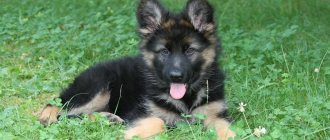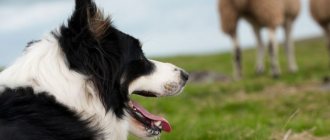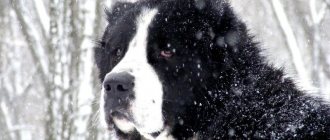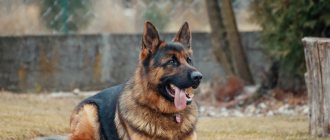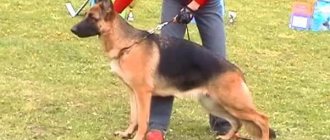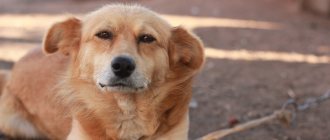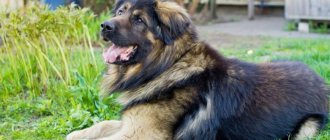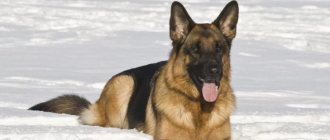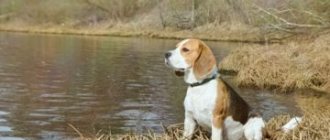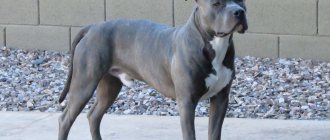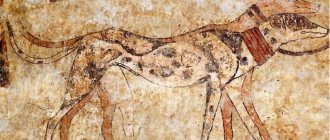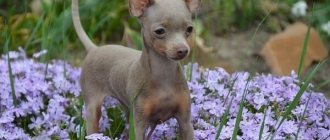Tobet is a Kazakh Shepherd Dog, a wolfhound, whose name translated means “dog on the mountain.” The Tobet breed is particularly widespread in the Far East and Eastern Europe. This is the pride and even one of the wonders of Kazakhstan. Not many people know, but it was the Kazakh tobet that for a long time was the secret of nomads and steppe peoples. He was a guard, hunter and laborer for four thousand years, but the Tobet dog was not depicted on any image of the nomads. But in 2014, an image of an animal of this breed appeared on a 500 tenge coin issued by the National Bank of Kazakhstan. What is the Tobet breed, what does this wolfhound look like, its price - let’s lift the veil of secrecy and find out who this “dog sitting on the mountain” is.
Origin story
The Tobets in the form in which they are presented today were formed approximately 3000-4000 years ago. This is evidenced by excavation data and rock paintings discovered on the territory of the Almaty region. It turns out that the Tobet is a representative of one of the oldest breeds, a witness to the entire history and life of the Kazakhs. The first European to describe the Tobets was Marco Polo. He said that these were huge dogs the size of donkeys, very strong and surprisingly friendly. They are used for protection, hunting wild animals and as draft power.
Large male leaders always choose a place on a hill, from where the entire territory can be clearly seen. Hence the name of the breed: “tobe” means hill, “it” means dog, “tobe it-tobet” means a dog on the top, a mountain dog.
The main enemy of livestock in the steppes of Kazakhstan is wolves, and the only salvation from them has always been tobets. In the 20th century, when everything began to be systematized, these wolfhounds were classified as Central Asian shepherd dogs and assimilated with the Alabai. The number of Tobets was also negatively affected by the state of livestock farming, lack of competent breeding work, uncontrolled shooting of dogs and cross breeding. Today, enthusiasts are reviving the breed, pointing out that the Tobet is a national treasure of Kazakhstan that needs to be preserved and increased.
The size of a dog compared to a person
A comparison of the size of the Central Asian Shepherd Dog next to a person can be shown by its height at the withers or when it stands on its hind legs.
Thus, the average height of adult Alabais at the withers is at least 70, and more often 80 cm, which indicates that the head of a pet of this size will be almost at the level of the knees of a person of average height.
Standing on their hind legs, these dogs can be the same height as their owner or even taller.
So, when the largest, in fact, even huge, Alabai in the territory of the former USSR, nicknamed Bulldozer , stood on its hind legs, its height was about 2 m, which exceeded the height of its owner.
Appearance
The appearance of the tobet personifies strength and power. The dog is large, has a rough build and tends to be damp. Stretched case. Sexual dimorphism is well expressed. The average height of a male is 72-75 cm, weight is 50-60 kg.
The head is heavy with a simplified top, powerful skull. The brow ridges and the occipital protuberance are clearly marked. The forehead is wide and flat. The transition to the muzzle is smooth, but well defined. The muzzle is shorter than the skull. The bridge of the nose is wide and rectangular. The lobe is large and black. The upper lip is thick, covers the lower lip, and often forms jowls. The cheekbones are powerful. The lower jaw is wide. The ears are small, triangular in shape, and usually cropped short. The neck is powerful with well-developed dewlap.
The body is massive with a deep and wide chest. The loin is well developed and wide. The back is hard and elastic. The stomach is low. Subcutaneous tissue is well developed throughout the body, but especially in the neck, withers, and chest. The legs are muscular, massive, of medium length. The tail is long, set moderately high, and well feathered. Often docked briefly.
In some farms, the tails of only females are docked; males are left at their natural length so that they can be easily distinguished in the herd.
The coat is coarse, tightly pressed to the body with a well-developed undercoat. The length of the spine reaches 10 cm. On the neck of male dogs, the hair often forms a mane. On the front surface of the legs and head, the hair is thinner and shorter. A distinctive feature of tobet wool is its water resistance. The colors are not too varied: black, brown, red, gray. These colors can be of various shades and combinations: single-color, two-, three-color.
Vaccinations for Kazakh greyhounds
Vaccination is carried out against the following diseases:
- canine distemper or distemper;
- parvovirus enteritis - the causative agent is parvovirus;
- infectious hepatitis - causative agent hepadnavirus;
- parainfluenza;
- rabies;
- leptospirosis;
- coronavirus;
- trichophytosis.
- At 2 months the first vaccination is carried out. After the injection, the puppy should not be washed, overfed or taken outside. Immunity after the first vaccine is developed within 12 days; this period becomes the most dangerous for the baby. A person needs to make a lot of effort to alleviate the puppy’s condition. After the first vaccination, puppies experience increased body temperature, general weakness and diarrhea.
- After 3 weeks, the puppy is given a second vaccination, but with the same vaccine. As a rule, after the second vaccination the dog feels much better, but for 12 days it must be protected from other animals, from drafts and not taken out for walks. After this time, walks are allowed.
- At 6 months of age, the puppy is vaccinated against rabies and a complex vaccine against several diseases. It is forbidden to vaccinate if the dog's teeth are changing. You need to wait until all the teeth are replaced, and then vaccinate the baby.
- At one year of age, the dog is given a comprehensive vaccine.
- Further, once a year the dog should be vaccinated with the same complex vaccine.
Only a qualified specialist should vaccinate a puppy.
Before vaccination, he must examine the dog, measure its body temperature, and only if everything is normal, give the injection. The vaccine is placed either in the scruff of the neck or in the hip of the dog. The entire list of vaccinations administered by the veterinarian must be recorded in the dog’s passport. It also indicates the date of vaccination; subsequently, the owner himself will know the expected date of the next vaccination.
Character and behavior
Kazakh Tobets are calm, balanced dogs with a pronounced territorial instinct, natural guard dogs. They are characterized by social behavior and aggression towards potential rivals. Issues of primacy are often resolved through a struggle that does not end in death. Each dog takes its own position and performs its duties. In relation to humans, Tobet is loyal, unobtrusive and independent, he is a friend and helper, and behaves as an equal. He is always happy to receive praise; he will not specifically ask for affection. Barks a little. In an unfamiliar environment, he behaves calmly and confidently. He has a very high intelligence, is able to assess the situation and make decisions. Tobet is not a companion who will sit at the owner's feet, but he is always nearby.
Tobet, unlike many other wolfhounds, is quite friendly towards people. Including to strangers. If the owner is nearby, the dog will let the person into the protected area and greet him with a wag of his tail. It’s interesting that during the day they will allow you to leave, but at night they won’t let you out without the owner’s permission. At night, the Tobets cordon off the perimeter of the protected area and conscientiously guard its borders.
In true tobet there is philanthropy and tranquility. The Kazakh wolfhound will never touch a child, even if he is already tired of his whims.
From the outside it may seem that Kazakh wolfhounds are lazy. This opinion is misleading. Dogs will indeed lie quietly if nothing is happening around them, but at the same time they never lose their vigilance and, if necessary, will instantly be where they need to be. Real Tobets are not a priori afraid of wolves. If a dog runs away after smelling a wild animal, it means that other blood flows in its veins. To protect an average flock of sheep from wolves, only one Kazakh tobet is needed. He raises his voice, and the beast does not dare to attack. Wolves also sense a force that can stop or cripple them.
Interesting Facts
You can find many interesting facts about the life of the Tobets. Here are a few of them:
- When a sheep gives birth to a lamb, several dogs remain on guard, while the rest continue to look after the grazing flock.
- Young female Tobets have their tail and ears trimmed a few days after birth. This will protect them from injury when attacked by wolves.
- The tails of male dogs are left untouched so that the difference between the sexes of the dog can be seen. In addition, for a proud male, a raised tail is a symbol of superiority over other animals.
- In ancient times, wolfhounds were fed from bowls covered with wolf skin. This taught us from an early age not to be afraid of the smell of a predator, perceiving it as accessible prey.
A dog like the Kazakh Tobet has long become legendary. Despite its large size, it is not scary for humans. Smart and responsible wolfhounds will become helpers in the household and good friends with proper care.
Content Features
Tobets are perfectly adapted to life in a sharply continental climate with large temperature changes. Developed subcutaneous tissue, along with thick wool, helps maintain temperature balance in the body, and during periods of lack of water and food, protects against exhaustion, like the fat tail of a sheep.
Tobet is not suitable for city life and especially apartment life. This dog needs space, the opportunity to work and be useful. Can be used to guard a private home, but the most suitable option would be to live on a farm, working with a herd in a pack of other dogs.
"Pedigreed" diseases
Due to its age-old hardiness (the nomadic life of its ancestors, protecting the herd from the wolf, adaptability to life in various conditions), this breed is not prone to disease . But if not properly cared for, she may develop some diseases.
Firstly, joint dysplasia . All large dog breeds suffer from this. Joint diseases can develop due to improper feeding in childhood. When an animal quickly gains weight, but the bones have not yet had time to get stronger. So the owner should understand that the animal grows and matures slowly. And this process will not become faster if the pet is simply overfed.
Secondly, if you overfeed an animal, it can become obese . The dog may also develop various stomach diseases, volvulus, etc.
As you can see, health problems for your pet can arise due to improper feeding and care. To prevent this from happening, you should pay attention to the animal’s diet, visit a veterinarian with him and consult on issues of interest.
Where to buy a Tobet puppy
Buying a true Tobet puppy is not an easy task. The breed is very rare. A huge amount of work to revive it is being carried out in the Tobet Kazaky It nursery and some others. In the West they are ready to pay huge sums for a “friendly wolfhound”, but there are not enough puppies for everyone. Complicating the choice of a good puppy is the fact that not all dogs, which their owners call Tobets, meet the requirements of exterior and character. Sometimes similar-looking dogs caught somewhere in the steppe are passed off as Tobets.
According to some data, there are several dozen real Tobets left in Kazakhstan.
Price
On the Internet there are advertisements for the sale of Tobet puppies (mainly on Kazakh websites). The average price is 100,000 tenge (approximately 17,000 rubles).
Mating
Estrus (or, as it is also called, the first mating) occurs in a dog at one year of age. A female usually has a void twice a year, but there are also cases when a greyhound has a void once a year or every 2 years. In this case, the female can be mated only at one and a half years of age. Until this time, she is not yet developed enough to whelp.
If you refuse to mate, after a week of emptying, you need to lock the female in a safe place for 15 days, and take her out for walks only on a long narrow belt. This will not harm the dog, since whelping makes the dog's body weaker, which leads to premature aging.
How to properly care
Alabai care includes:
- regular feeding. Food should be balanced, appropriate for the dog’s age, and contain many vitamins;
- periodic combing and haircuts. If the dog does not live in the north and does not need a thick skin, it can be cut, but the coat will have to be combed constantly;
- vaccinations. Like any animal, Alabai needs vaccinations, for example, it needs to be vaccinated against rabies;
- walks. If the yard is small and there is not enough space for the dog, then you will have to constantly walk the Alabai; without walks, he will get bored, become lethargic and inactive.
Regular mating of animals during estrus and subsequent care of puppies are also important.
Note! The Alabai can spend most of the year in an open enclosure; its fur coat protects it from both cold and heat. But it’s better to build a dog house
Features of caring for bitches
The first heat occurs in Central Asian Shepherds at the age of 2 years, but usually breeders do not recommend breeding dogs at this time; it is better to wait at least 1 year. This will avoid multiple pregnancies and miscarriages.
Estrus time is August-September. Estrus occurs once or twice a year, the best time for mating is the end of winter. Pregnancy lasts 60-65 days. You can recognize it by the presence of discharge from the loop, which appears in the third week after mating.
Important! During pregnancy, bitches become aggressive and need increased nutrition; food should be rich in vitamins. Childbirth in most cases goes smoothly
If the bitch is young and there are a lot of puppies, then you should expect them to appear a few days earlier
Childbirth in most cases goes smoothly. If the bitch is young and there are a lot of puppies, then you should expect their appearance a few days earlier.
Feeding a bitch during pregnancy requires a large amount of vitaminsNutrition
It is better to find out what the alabai eats directly from the breeder. Typically dogs of this size are fed:
- special feeds;
- porridge;
- bones;
- meat;
- fish.
An Asian dog's daily diet must include boiled and fresh vegetables and vitamins. You need to feed 2-3 times a day, the dog needs a lot of food, but should not be allowed to become obese. There must be fresh water in the bowl.
Walk
Alabais are walked on a leash and muzzle, like most dogs. Children and elderly people should not be entrusted with walking dogs; if the dog is not sufficiently trained or feels like a leader, then it can snatch the leash from a person’s hands and run away in pursuit of a cat or another dog. If the dog is not trained, walk it only away from residential buildings and people. Central Asian shepherd dogs are released into the urban environment on a leash and in a collar only after they have mastered basic commands.
Important! Walk frequently, at least twice a day. The dog needs constant movement, it is not a chain dog, a purebred Alabai needs space
Price
Alabai is considered a unique dog, an exception to the rule.
And before you buy a dog, based on breed standards, you should think twice. After all, even if an animal has ideal external characteristics, expectations may still not be met due to its stubborn disposition. These dogs have a special psyche, unlike anyone else. In addition, the four-legged pet is prone to dominance. The cost of the animal should not be low if we are talking about a dog with a pedigree. And the future owner must trace it. If a private official breeder or nursery values its reputation, then in addition to the pedigree certificate, it will also present other documents for the four-legged animal, including vaccination certificates.
Newly born Alabai puppies
This paperwork makes sense. Thanks to her, it will be possible to choose the best of your breed. After all, no one wants to waste their time on trifles. The price of an Alabai with a pedigree starts from 15 thousand rubles, and the upper threshold fluctuates around 60-70 thousand rubles.
It is ideal if the owners meet the mother and father of the future pet. Usually the rule with Alabai is “similar color - similar character.” If a dog looks like his parents in appearance, then most likely he will resemble them in character. Reviews from breed owners confirm this.
Everyone who has ever opened a browser page with a question about a purchase has come across, in addition to nursery websites, the Alabai Help resource. The creators of the portal themselves state that this is not a shelter, not a nursery or a foundation, but a charitable organization dedicated, in accordance with its name, to helping and saving this breed.
We are talking about dogs deprived of a roof over their heads, left without a home. From this organization you can also purchase a dog for your home, but, of course, most likely it will be deprived of documents, pedigree and vaccinations.
Besides, it's unlikely to be a puppy. But you can do a good deed and save the poor fellow. But since these animals are often taken for protection, a discount can be made on age. The main thing is that the dog is not too old.
Varieties of Alabaev
Wolfhound subspecies have been selected in almost all Asian countries. They have some differences, depending on their habitat, but family ties are clearly visible.
Here are the most famous types:
- Tibetan mastiff. A rare and expensive dog that can survive in harsh conditions. Mastiffs are tall and powerful, with thick hair in the neck area that extends into the mane. They are calm, with a rather gentle character and love children, but you should not leave them alone.
- The Turkish Kangal is one of the most ancient breeds. Very obedient, kind, hardy and brave, but at the same time distrustful. Gets along well with other pets. Most often used for protection.
- The Uzbek Buribasar stands out from other Asians due to its smaller size and elongated muzzle. An easy-going dog with developed intelligence.
- The Siberian Alabai is a cross between a German Shepherd and a Siberian Husky. Obedient, smart and sociable.
- The Afghan Alabai is very strong and is often used for hunting. It is not recommended to keep him with other pets. Extremely willful, takes a long time to get used to people.
- The Alaskan Malamute is wolf-like in appearance, hardy and friendly, but can be stubborn. Dogs are used to transport goods, and not as guards, because they are absolutely devoid of aggression.
- The German Alabai is a cross between an Indian wolf and a German dog. Very smart, senses danger, fearless and mentally stable.
- The Armenian Gampr has a distinctive external feature – powerful jaws. He becomes very attached to a person if he proves his dominance.
- Kazakh tobet is the least common today and is on the verge of extinction. They are strong and unpretentious.
- The Kyrgyz debit is another endangered species of alabai. In the eighties of the last century, they were actively destroyed because they were considered spreaders of rabies.
- The Tajik Alabai is the largest and resembles a St. Bernard, good-natured and reserved.
The Turkmen Alabai is taken as the basis for the characteristics of the modern factory breed. Most of all, he is similar in psychotype to another representative of wolfhounds - the Caucasian Shepherd Dog. It is impossible to say with certainty which of them is stronger. Alabais are slightly larger and more massive, but less stubborn and aggressive. Here it is worth taking into account the tasks set by breeders when creating breeds. If a Caucasian is aimed at destroying the enemy, then the shepherds rejected dogs that attacked the owner. Asians are characterized by a clear division into friends and foes.
The Alabai breed standard was first registered only in 1989. In 2010, changes were made to it, in particular, the maximum permissible height of a shepherd dog was increased by 5 cm. Currently, Alabais are in demand in the security field, so very stringent requirements are imposed on selection and training.
Behavioral specificity
The Turkmen wolfhound has a number of other behavioral features. It would seem that a character formed in the vast expanses of mountains, deserts and semi-deserts should be particularly aggressive. In these open spaces, people and livestock were in danger from natural disasters, the fangs of other predators, and most importantly, from other people. After all, in these parts there have long been robbers who traded not only in the theft of livestock and property, but also in the slave trade.
However, this dark past strangely affected the character of the Alabais, especially the Turkmen ones. If these dogs are close to the flock and their owners, then an approaching stranger will be stopped by a moderate, non-aggressive bark. This is just a warning that continues until the owner finds out what the person came with. If the situation is peaceful, then the Alabai will never show aggression towards a new person, allowing him to be in the given territory unhindered.
So these dogs have a generally positive attitude towards people. However, only until the person came to them in peace.
It’s another matter if these Alabai do not have a nearby object of protection and the will of the owner to guide them. In small Turkmen villages, where it is not customary to keep chain dogs, Alabais gather in packs and begin to guard the village itself, controlling its perimeter.
If suddenly, under the cover of darkness, when the inhabitants of the village are sleeping, a random traveler enters this territory, then the Alabai will receive him in their own way. A well-coordinated flock surrounds such a person, trying to get behind him. If the traveler’s nerves are strong and he does not run, then a characteristic carousel will form. The man, turning to face each of the dogs, constantly spins in place. Each dog, trying to get behind his back, is forced to run in a circle all the time. We must give these dogs their due, such a carousel does not last long. If it turns out that a person has strong nerves, does not use weapons, does not call for help, then the pack, with a sense of fulfilled duty, runs away on its security duties.
Clothes for the Afghan Hound
Clothing will not only help preserve its health, but will also give the dog the opportunity to fully enjoy the walk.
And any owner will be pleased to lead a dog on a leash, which many people pay attention to. The main thing when choosing clothes is to remember to choose not only beautiful and warm models, but also the most comfortable ones.
A jumpsuit for an Afghan hound will protect you from slush and rain, because the coat of this dog requires constant and careful care.
Buying clothes for a greyhound is now easy. Many stores selling clothing for animals have in their assortment stylish and beautiful things for dogs of all breeds.
Recommendations for caring for Tobet
- The wool
is combed more often during the molting period in order to quickly free the tobet from dead undercoat. Water procedures are carried out extremely rarely. - Ears
are checked and cleaned if necessary. - Eyes
do not require special care. - teeth
cleaning from an early age. If this is not possible, then give cartilage and hard sinews of cattle for prevention. - the claws
grow, they are trimmed regularly. - The diet
consists mainly of meat and organ meats, with the remainder including fiber and complex carbohydrates. Additionally, provide your beloved four-legged friend with vitamins and minerals. All natural nutrition can be replaced with ready-made concentrates from well-known manufacturers. Its composition is correctly selected and has an extremely beneficial effect on the body. - Walks
should be long. Of course, it is better to keep the Kazakh wolfhound on private lands, in an enclosure. He must receive appropriate workloads and attend to his direct responsibilities.
Brief historical background
The true origin of Afghan hounds is shrouded in darkness and hidden in the depths of centuries. The breed is considered very ancient, but at least the approximate date of its origin is unknown to anyone. Scientists dated rock carvings of canids, which have a strong visual resemblance to Afghans, found in Iranian caves to the 9th-10th centuries BC. Similar drawings were also discovered in the east of Afghanistan; they were painted later - in the 2nd century BC. e.
Dogs of this type lived in the vast steppe and semi-desert territories of South and Central Asia, in the mountainous areas of the Tien Shan and Pamirs. According to some studies, the closest relatives of the Afghan hounds are the Saluki, the oldest native Middle Eastern breed, whose history goes back several thousand years. There are two main types of greyhounds (in fact, there are about 13 of them in Afghanistan alone):
- mountain - with long hair that protects from harsh climates;
- steppe - with a rather short coat.
The animals were used by local residents to hunt various game and also as guards and were especially valued for their running speed, tirelessness and ability to persistently and recklessly pursue prey.
The modern history of the breed begins at the very end of the 19th century, when its first representatives were brought to England by British officers returning from Persia, India, and Afghanistan. Animals participated in various exhibitions and competitions as exotic novelties. A dog named Zardin (owner - Captain Bariff), who won many (more than 50) victories in similar competitions, entered the annals of history. His appearance formed the basis of the first breed standard (1925). At the beginning of the 20th century (20s), there were two competing nurseries, in one of which Pakistani animals with relatively short hair were bred, while in the other, preference was given to long-haired people from Afghanistan. The modern appearance of the Afghan Hound was formed by crossing these lines.
The Zardin dog is considered the ancestor of all modern Afghan hounds.
The breed was registered with the FCI (Federation Cynologique Internationale) in 1965. The final version of the breed standard was approved in June 1987 at the Jerusalem General Assembly. The current document is dated December 12, 2011, the breed is included in group 10 - greyhounds, section 1 - long-haired greyhounds or greyhounds with hanging hair under No. 228.
Walk
The Asian is a very large dog. And a city apartment is not the best place for such a breed.
- She will feel good in a private household, where you can set up a large enclosure for her.
- This applies to older puppies and adult dogs. But it is better to place a small puppy in the house until he gets stronger.
- A stronger puppy can be safely transferred to an enclosure.
- But if, after all, a fan of this breed lives in a city apartment, then he must provide his dog with two walks a day for 2 or more hours each.
And if a dog can get around in an enclosure without a leash, then when going for a walk in an urban environment with a Central Asian Shepherd, you need to have a muzzle and a high-quality leash.
